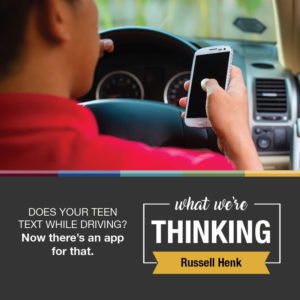What we’re learning about the battle against the coronavirus could go a long way in helping us thwart vehicle crashes. It’s a simple lesson:
Prevention – in the form of personal responsibility – can help us contain the public health crisis of COVID-19, and it can do the same with the epidemic of distracted driving. Masks don’t absolutely guarantee against contagious transmission, and leaving a phone out of reach in the car doesn’t absolutely eliminate all potential driving hazards. But in each case, such safeguards can vastly reduce the likelihood of harm.
Cell phone use has more than doubled in the past decade, according to the Pew Research Center. And a staggering share of that use happens when we’re driving, according to research conducted earlier this year by State Farm.
Despite the widely acknowledged danger, many people remain stubbornly insistent upon using their phone for talking, texting, and selfie snapping when they’re behind the wheel. State Farm’s research showed that nine out of ten drivers say they engage in distracted driving behaviors – nine out of ten. Perhaps we shouldn’t call it a “smart” phone when so often we use it for things that are anything but intelligent.
The need for prevention measures is particularly urgent for the most risk-prone motorists – those under the age of 25. Car crashes constitute the number-one cause of serious injury for that demographic, and they’ve been the top cause of death for this age group for decades.
That’s true for two reasons. The prefrontal cortex of the brain – the part that processes judgment– is not fully developed until we’re in our mid-twenties; and, novice drivers lack the experience that’s essential to developing safe driving skills. Consequently, those drivers are more likely than others to be in a crash, and distractions (mostly resulting from texting, talking, or interacting with social media platforms on a phone) lead to more such crashes than any other cause.
We’ve long relied mostly upon laws and punishment to motivate safer driving habits. And while there’s certainly a place for using a stick on this problem, we’ve also found success recently by employing a carrot – a smartphone app that offers rewards to young drivers who refrain from using those phones while driving. Points earned for safe driving can be redeemed for gift cards for food and other prizes. And the app is working. Our preliminary assessment shows a 65 percent reduction in cell phone use behind the wheel for the younger crash-prone age group. In trying to minimize risk and keep things safe for the youngest people behind the wheel, it helps to know when and where the carrot holds more promise than the stick.
It also helps to know that the messenger is often just as important as the message. That reality led us to create Teens in the Driver Seat, the nation’s first peer-based program of its kind. And after 20 years, the young people who direct the program have distracted driving at the top of their priority list.
Of course, there’s no one-size-fits-all solution to the distracted driving problem, and there are no magical cures for the most risk-prone drivers.
There are also limits to what laws can do. All too often, we create laws to compel us to do as citizens what we should voluntarily be doing as humans — which brings me back to the notion of personal responsibility.
Benjamin Franklin was right. Prevention is typically a lot cheaper (and simpler) than treatment. That’s true for the outbreak of a deadly disease, and it’s also true for the spread of a deadly behavior.
Russell Henk is a senior research engineer at the Texas A&M Transportation Institute.
This article was originally published in the Dallas Morning News, August 24, 2021.
